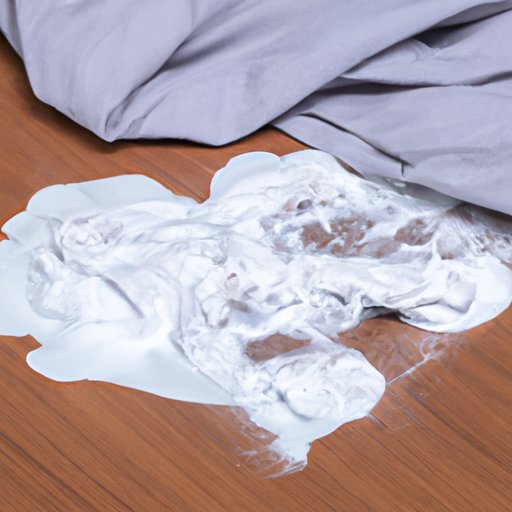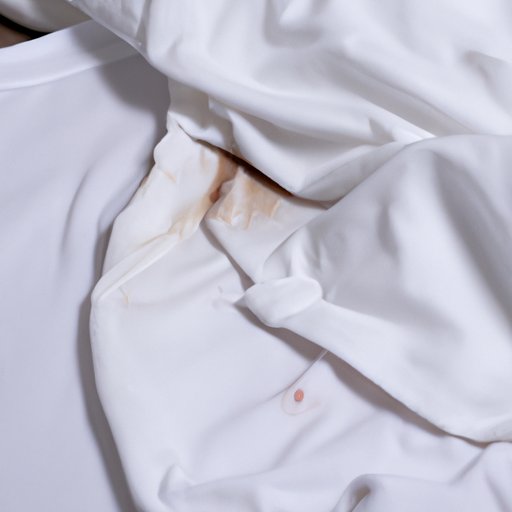
Introduction
It’s happened to all of us: you nick yourself shaving, get a paper cut, or have a nosebleed only to discover that your clothes have been stained with blood. Blood stains can be tough to remove and if not treated properly, they could become permanent. But don’t worry, with a little know-how and the right techniques, you can get your clothes looking like new again. In this article, we’ll explore some simple and effective ways to remove blood stains from clothing.
5 Simple Home Remedies to Remove Blood Stains from Clothes
When it comes to blood stain removal, sometimes the simplest solutions are the most effective. Here are five easy home remedies you can use to remove blood stains from clothes:
Method 1: Cold Water and Salt
Start by blotting the stain with a clean cloth or paper towel. Next, soak the stained area in cold water with a tablespoon of salt for 30 minutes. Rinse the clothing in cold water and repeat the process if necessary before washing.
Method 2: Hydrogen Peroxide and Dish Soap
Mix one tablespoon of dish soap with two tablespoons of hydrogen peroxide. Apply the mixture to the stain and let it sit for about 10 minutes before blotting with a clean cloth. Rinse the area in cold water and repeat if necessary before washing.
Method 3: Meat Tenderizer and Water
Mix a tablespoon of meat tenderizer with water to create a paste. Cover the stain with the paste and let it sit for half an hour before rinsing with cold water and washing.
Method 4: Ammonia and Water
Dilute a tablespoon of ammonia with a cup of water. Apply the mixture to the stain and let it sit for 5-10 minutes before washing.
Method 5: Vinegar and Baking Soda
Mix one tablespoon of baking soda with one tablespoon of water to create a paste. Rub it onto the stain and let it sit for 30 minutes. Mix equal parts water and vinegar and pour it on top of the stain. Let the mixture bubble up and then rinse with cold water.
The Ultimate Guide to Removing Tough Blood Stains from Clothing
For tougher blood stains, you might need to use a more extensive stain removal process. Here’s the ultimate guide:
Pre-treatment
If the stain is still fresh, blot it with a clean cloth or paper towel to remove as much blood as possible. Don’t rub it as this could spread the stain and make it harder to remove.
Soaking
Soak the stained clothing in cold water for at least an hour, or even overnight. If the stain is still stubborn, add a bit of laundry detergent and a stain remover to the mixture.
Detergent and Stain Remover
Once the stain has been pre-treated and soaked, apply laundry detergent directly to the stain and let it soak for 15-30 minutes. If you’re using a stain remover, follow the instructions on the package and let it sit for the recommended time.
Rinse and Repeat
Rinse the clothing thoroughly in cold water and check for any remaining stain. If there is still some remaining, repeat the process and let it soak overnight before washing again.
Say Goodbye to Stains: Effective Methods to Remove Blood from Clothes
Using Commercial Stain Removers
If you don’t want to go the DIY route, there are plenty of commercial stain removers available on the market. Follow the instructions on the package closely and test on a small, inconspicuous area first to avoid any potential damage to your clothing.
Tips for Removing Stains from Different Fabrics
Depending on the fabric, you might need to take extra precautions when removing blood stains. For delicate fabrics such as silk or cashmere, use cold water and a gentle detergent. For white cotton or poly-cotton blends, you can use a bleach solution, but be careful not to damage the fabric.
DIY Blood Stain Removers: How to Get Sanguine Splotches Out of Your Clothes
Lemon Juice and Salt
Mix equal parts lemon juice and salt to create a paste. Apply it to the stain and let it sit for 10-20 minutes. Rinse with cold water and wash as usual.
Cornstarch and Milk
Mix cornstarch with enough milk to create a paste. Apply the mixture to the stain and let it sit for an hour. Rinse with cold water and wash as usual.
Baking Soda and Water
Mix baking soda with enough water to create a paste. Apply it to the stain and let it sit for 30 minutes. Rinse with cold water and wash as usual.
From Peroxide to Baking Soda: 7 Household Items That Can Remove Blood Stains
Hydrogen Peroxide
Hydrogen peroxide is a powerful stain remover and can be effective for removing blood stains. Mix it with a bit of dish soap and apply it to the stain before washing.
Vinegar
Vinegar can be used as a pre-treatment for blood stains. Soak the clothing in a mixture of water and vinegar before washing.
Lemon Juice
Lemon juice contains natural bleaching agents and can be effective for removing blood stains. Mix it with salt or baking soda to create a paste and apply it to the stain before washing.
Salt
Salt can be used as a pre-treatment for blood stains. Soak the clothing in cold water with a tablespoon of salt for 30 minutes before washing.
Meat Tenderizer
The enzymes in meat tenderizer can break down the proteins in blood stains. Mix it with water to create a paste and apply it to the stain before washing.
Ammonia
Ammonia can be effective for removing stubborn stains. Dilute it with water and apply it to the stain before washing. Be sure to rinse thoroughly afterward.
Baking Soda
Baking soda can be mixed with water to create a paste that can be applied to the stain before washing. It can also be added to laundry detergent to boost its stain-removing power.
No More Stubborn Blood Stains: A Step-by-Step Guide to Cleaning Clothes
Identifying the Stain
Before treating a stain, it’s essential to identify what caused it. This can help you choose the most effective treatment and avoid damaging the fabric.
Treating the Stain
Depending on the type of stain, you might need to use different methods and products to remove it. Refer to the different sections in this article for specific instructions.
Washing the Clothes
Once the stain has been pre-treated and soaked, wash the clothes according to the care label instructions. Be sure to use the right temperature setting and laundry detergent.
Drying the Clothes
Avoid drying clothes in a dryer if there is still a stain. The heat can set the stain and make it even harder to remove. Hang the clothes outside to dry if possible, or lay them flat on a towel indoors.
Checking for Remaining Stain
Before storing the clothes away, check for any remaining stain. If there is still some residual stain, repeat the treatment process and wash again.

How to Remove Blood Stains from Clothes: Tried and Tested Methods for Spotless Results
Importance of Treating Stains Immediately
The key to effective stain removal is to treat it as soon as possible. The longer you wait, the harder it will be to remove the stain. So don’t let the stain sit for too long!
Using the Right Products and Techniques
Refer to the sections in this article for specific products and techniques to remove different types of blood stains. Always follow the care label instructions on your clothing, and test any new products on a small, inconspicuous area first.
Tips for Preventing Future Stains
If you’re prone to getting stains, consider wearing protective clothing or using a bib. Keep a stain remover on hand, and be sure to clean stains as soon as they happen to prevent them from setting in.
Conclusion
Removing blood stains from clothing is never fun, but with the right techniques and products, it can be done effectively. We’ve explored some simple home remedies and more extensive stain removal processes, as well as the different household items that can be used to remove blood stains. Remember to treat stains as soon as possible and to always follow the care label instructions on your clothing.




